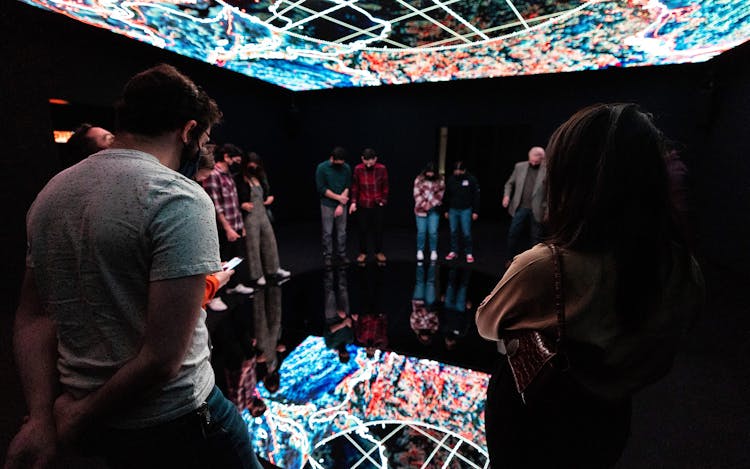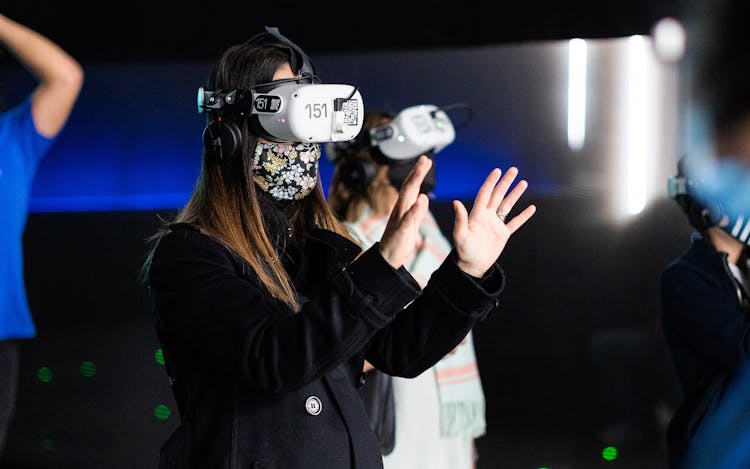27.01.2022
A new virtual reality experience launches you to the International Space Station, where you join the crew and see Earth like you’ve never seen it before.

The virtual reality exhibit and several installations are on view at Houston’s Sawyer Yards through February 20. Above: Ryoji Ikeda’s “The Universe Within the Universe."Melissa Taylor Photography/Public Content
Decades ago, before billionaires could hitch rides into orbit, space exploration seemed like a more poetic endeavor.
I grew up in Dickinson, less than ten miles from NASA’s Manned Spacecraft Center, when it was still easy to name all the astronauts training there. I went to church and school with kids whose dads were among the pocket-protected brigade of genius engineers, including flight director Gene Kranz, the guy Ed Harris portrayed in Apollo 13.
As a college student in the 1970s, I had a summer gig as a proofreader at the Lunar Science Institute, in the “Diamond Jim” West Mansion just east of NASA’s back gate. Jovial, unkempt, caffeine-fueled scientists toiled at night in a room a few steps from my desk, sharing time on a huge mainframe and producing papers about moon rocks and soil samples. I only vaguely understood their work, but it felt important, and I kept their nouns and verbs in agreement and their capitals and commas in place.
By then, everyone knew what Earth looked like from space; the Apollo 17 crew’s famous “Blue Marble” photograph, which will be fifty years old this December, had become ubiquitous. Today, closer views of our planet stream continuously from the International Space Station on cellphones and laptops, freely accessible, like so many other twenty-first century amenities born from our ability to launch gadgets into the sky. I wonder if anyone will remember how meaningful that first whole-Earth image was.
“The Infinite,” a new virtual reality encounter, aims to revive that old sense of wonder. It might even give you the “overview effect,” a visceral moment of clarity astronauts often experience when they view our planet from afar—a near-spiritual vision of humanity as a single species on a vaporous and vulnerable blue ball within the universe.
Set up at Houston’s Sawyer Yards through February 20 (then heading to Seattle), “The Infinite” was filmed by astronauts aboard the International Space Station between January 2019 and September 2021. Using a custom video camera that produces ultra-high-definition, 3D, 360-degree views, they recorded short scenes outside (and inside, filmed with a smaller 360-degree camera) of the ISS to show how they live and work, as well as glimpses of Earth and the farther reaches of space from the orbiting laboratory. Some of that material was released last year as a four-part film series, Space Explorers: The ISS Experience, by Montreal’s Felix & Paul Studios (which also designed the outside camera) and Time Studios. The Space Explorers series won last year’s Emmy for Outstanding Interactive Program.
I love a good VR happening. One of the best I’ve been to is fine art: Laurie Anderson and Hsin-Chien Huang’s “To The Moon” delivers a fantastical lunarscape with dinosaurs that materialize from DNA strands and asteroids that morph into black diamonds. “The Infinite” is something else—truly virtual reality.
The entry of the exhibit, though, is inspired by 2001: A Space Odyssey. With a small group of strangers, I walked a ramp through a glowing white vinyl room into a metal chamber where lights flashed through seams in the walls. As the sliding doors closed, we heard the voice of astronaut Anne McClain, describing how raw she felt just before she launched into space. A countdown further fired up our juices. When the doors opened into a huge, dark room, we plucked our sanitized headsets from eerily lit floor-to-ceiling tubes. A minute or so later, I dissolved into stardust and re-formed as a female avatar with a bright green grid for skin.


A transparent rendering of the ISS hovered in the room’s center. The station’s ambient beeps and transmissions alternated with a celestial soundtrack through my headphones. I had to make myself walk “through” the rendering’s walls—a disconcerting feeling from the start—to reach the interactive orb-portals inside. With each orb visitors touch, a different 360-degree filmed scene appears. The show’s sixty portals are loosely organized into seven-minute chapters with inspirational names: “Adaptation,” “Progress,” “Unity,” “Expansion.” The portals are spaced around the room, roughly near the points of the station’s floor plan where they were filmed, and visitors choose which ones they will open. No one can get to all sixty during the show’s 35-minute duration, so each trip through is different. One of the organizers told me it took him six visits to find all the material. That would be costly (adult tickets are $36 to $65; kids, students, and seniors pay less).
I was literally lost in space, wandering cluelessly through the virtual laboratory during my first visit, and only slightly more oriented during a second. “The Infinite” dwells on the human aspects of life in the ISS—what it means to live and work 260 miles above Earth’s surface in a contraption that’s configured like a plumbing fixture under a kitchen sink and hangs from a truss structure the length of a football field. Even seemingly insignificant details absorbed me: rows of commemorative mission stickers affixed to surfaces; the Velcro strips everywhere, indispensable for holding virtually anything in place, including toothbrushes, laptops, and wrenches; the way long hair floats, Medusa-like, around faces.
The station’s tubular modules are cramped, with no discernible floors or ceilings and no real up or down, just four walls covered with a mind-boggling mess of wires, monitors, consoles, cargo compartments, and bags of supplies. This is no place for minimalists or claustrophobes. And then there’s the constant dance with microgravity. The astronauts drift gracefully through the station’s tunnels like khaki-clad sea creatures, hooking their sock-covered feet under footholds or grabbing handholds when they need to be stationary or maneuver through modules.
I watched them toss a football, share a meal, jog on a treadmill, explain how their “outhouse” works, say goodbye to departing crewmates, and monitor the gazillion science experiments that hang out in the walls. I followed them into the cupola, an observation capsule that holds the station’s only windows. Life on the ISS is a wild mix of the unimaginable and the mundane. The housecleaning never ends. The internet service is sketchy. Face time with families is sacred.
Preparing for an EVA, or extravehicular activity—i.e., a space walk—takes weeks: suits must be readied, every move planned. Just suiting up takes hours. Visitors to “The Infinite,” however, can step through the transparent walls of the virtual ISS to be “outside” in a few seconds. A few orbs beckoned to me from somewhere near the truss structure, and I went for them. I knew my boots were firmly planted on a thinly carpeted floor, but I still felt disembodied and dwarfed by a tower of panels that glinted in the sun. Just an arm’s length away, other parts of the ISS looked shockingly Rube Goldberg–like, with exposed wires, sensors, satellite dishes, and the gangly robotic arms that grab arriving cargo and crew vehicles. I was close enough to read the logos on module exteriors—JAXA (Japanese Aerospace Exploration Agency), ESA (European Space Agency), SpaceX.
Then I looked down, and it knocked the wits out of me. Earth! Alive, immense, and bright blue beneath wispy brushstrokes of clouds, organic and palpably alive. My eyes teared up, then I went giddy. It wasn’t just that it was beautiful: something about the wholeness of the planet transcended the mayhem I knew humans were inflicting on it and themselves—something profound and hopeful. The overview effect.
I could have stayed all day, but a voice in the headset instructed me to follow a path of light to a chair where I would view the final scene. It took me outside the station again to “participate” in an EVA that was filmed last September. In real time, Japan’s Akihiko Hoshide and France’s Thomas Pesquet performed what would have been a mundane task if they hadn’t been tethered to a machine moving at over 17,000 miles an hour. They were installing a bracket on the truss structure, a full day’s work. I was just along for a few minutes’ ride, mesmerized by their movements but free to gaze beyond them, to Earth. When the scene ended, I felt like I could still walk on air.
I did not expect “The Infinite” to flip any switches in my brain. It had been light-years since I breathed the early NASA air of the Mercury, Gemini, and Apollo missions, watching every nail-biter launch and landing on TV. I have binged on YouTube videos shot from the ISS for days now, hoping to recapture the sense of Earth as a miraculously contained sphere. Even when the views are awesome, on my ordinary screen, the world remains stubbornly flat.
Quelle: Texas Monthly
